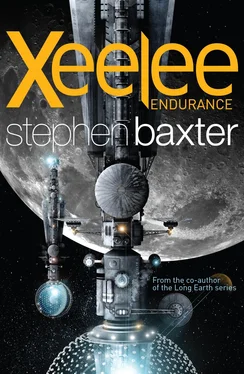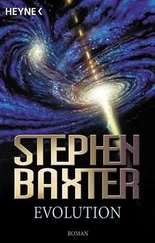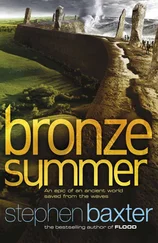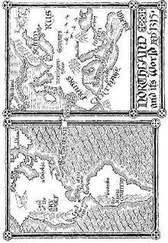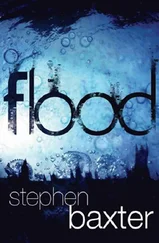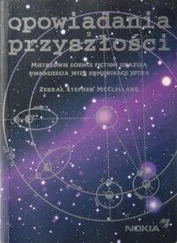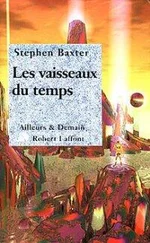They had, however, rearranged the interior to make it feel a little less cramped. The couches had been separated and set up around the cabin, so you could sit upright with a bit of elbow room. The cabin was pressurised so we could remove our helmets, and though the expandable walls didn’t work any more there was room for one at a time to shuck off his or her exosuit. Poole ordered us to do so; we had already been inside the suits for a few hours, and the suits, and ourselves, needed some down time. Poole had set up a curtained-off area where we could let our discarded suits perform their self-maintenance functions while we had showers – of water recycled from our urine and sweat, which was deemed a lot safer than melt from the ice moon. Poole himself used the shower first, and then Miriam. She was hasty, eager to get back to her work, and kept talking even while she cleaned up.
After Miriam was out of the shower I took my turn. It was a miserable drizzle and lukewarm at that, but it was a relief to let my skin drink in the water. I was quick, though; with the unknown dangers of Titan only centimetres away beyond the gondola’s fragile metal walls, I didn’t want to spend long outside the security of the suit.
It was scarcely a comfortable ride, even discounting the calculating face of Harry Poole glaring from wall-mounted slates. I was relieved when, after a couple of hours, we reached our destination.
At that point Bill Dzik was in the shower. Safely suited up, with Dzik’s offensive presence absent, I was able to sit forward in my couch and peer over Miriam’s and Poole’s shoulders at the landscape outside. That cryovolcano was a mound that pushed out of the landscape some kilometres to the west of us. It had the look of a shield volcano, like Hawaii or Mons Olympus, a flat-profiled dome with a caldera on the top. It wasn’t erupting while we sat there, but I could see how successive sheets of ‘lava’ had plated its sides. That lava was water ice, heavily laced with ammonia, which had come gushing up from this world’s strange mantle, a sea of liquid water locked under the ice, kilometres below our tyres.
As for the crater lake, I saw nothing but a plain, flatter and even more featureless than the average, covered with a thin scattering of ice sand. But the lake was there, hidden. Poole extracted radar images which showed the unmistakable profile of an impact crater, directly ahead of us, kilometres wide. Such is the vast energy pulse delivered by an infalling asteroid or comet – or, in Saturn’s system, perhaps a ring fragment or a bit of a tide-shattered moon – that the water locally can retain enough heat to remain liquid for a long time, perhaps thousands of years. Such a lake had formed here, and then frozen over with a thin crust, on top of which that skim of sand had been wind-blown. But the briny lake remained under the ice, hoarding its heat.
And, studded around the lake’s circular rim, we saw more sponge-like masses like the one we had discovered wrapped up in silane film at the shore of the polar lake. These masses were positioned quite regularly around the lake, and many were placed close by crevasses that seemed to offer a route down into the deep structure of the ice rock beneath us. Miriam started gathering data eagerly.
Meanwhile, Poole was puzzling over images returned from the very bottom of the crater lake. He had found motion, obscure forms labouring. They looked to me like machines quarrying a rock deposit. But I could not read the images well enough, and as Poole did not ask for my opinions I kept my mouth shut.
Miriam Berg was soon getting very agitated by what she was finding. Even as she gathered the data and squirted it up to Harry Poole in the Crab , she eagerly hypothesised. ‘Look – I think it’s obvious there are at least two kinds of life here, the silanes of the ethane lakes and the CHON sponges. I’ve done some hasty analysis on the CHON tissues. They’re like us, but not identical. They use a subtly different subset of amino acids to build their proteins; they have a variant of our DNA in there – a different set of bases, a different coding system. The silanes, meanwhile, are like the life systems we’ve discovered in the nitrogen pools on Triton, but again not identical, based on a different subset of silicon-oxygen molecular strings.
‘It’s possible both forms of life were brought here through panspermia – the natural wafting of life between the worlds in the form of something like spores, blasted off their parent world by impacts and driven here by sunlight and gravity. If the System’s CHON life arose first on Earth or Mars, it might easily have drifted here and seeded in a crater lake, and followed a different evolutionary strategy. Similarly the silanes at the poles floated here from Triton or somewhere else, found a congenial place to live, and followed their own path, independently of their cousins . . .’ She shook her head. ‘It seems remarkable that here we have a place, this moon, a junction where families of life from different ends of the Solar System can coexist.’
‘But there’s a problem,’ Bill Dzik called from his shower. ‘Both your silanes and your sponges live in short-term environments. The ethane lakes pretty much dry up every Titan year. And each crater lake will freeze solid after a few thousand years.’
‘Yes,’ Miriam said. ‘So both forms need to migrate. And that’s how, I think, they came to cooperate . . .’
She sketched a hasty narrative of the CHON sponges leaving the crater lakes as they cooled, and finding their way to the summer pole. Maybe they got there by following deep crevasses, smashed into Titan’s ice crust by the impacts that dug out crater lakes like this one in the first place. Down there they would find liquid water, kilometres deep and close to the ammonia ocean. It would be cold, briny, not to terrestrial tastes, but it would be liquid, and survivable. And at the pole they would find the silane lilies floating on their ethane seas. The lilies in turn needed to migrate to the winter pole, where their precious life-stuff ethane was raining out.
Miriam mimed, her fist touching her flattened palm. ‘So they come together, the sponges and the lilies—’
‘To make the Titan birds,’ I said.
‘That’s the idea. The timing must be complicated, but both need to migrate. The birds come flapping up out of the lake, just as we saw, heading for the winter pole: sponges as bodies or brains, silanes as wings, one seeking cold, one warmth, but both needing to be on the move. Maybe the sponges get dropped off at fresh crater lakes along the way, across the surface of the planet. It’s a true symbiosis, with two entirely different spheres of life intersecting – and cooperating, for without the migration neither form could survive alone.’ She looked at us, suddenly doubtful. ‘We’re all amateurs here. I guess any competent biologist could pick holes in that theory the size of Saturn’s rings.’
Dzik said, ‘No competent biologist would even be hypothesising this way, not with so few facts.’
‘No,’ Harry said tinnily from his slate. ‘But at least you’ve come up with a plausible model, Miriam. And all without the need to evoke even a scrap of sentience. Good job.’
‘There are still questions,’ Miriam said. ‘Maybe the sponges provide the birds’ intelligence, or at least some kind of directionality. But what about power? The lilies especially are a pretty low-energy kind of life form . . .’
Michael Poole said, ‘Maybe I can answer that; I’ve been doing some analysis of my own. I can tell you a bit more about the silane lilies’ energy source. Believe it or not – even on a world as murky as this – I think they’re photosynthesising.’ And he ran through the chemistry he thought he had identified, using entirely different compounds and molecular processing pathways from the chlorophyll-based green-plant photosynthesis of Earth life.
Читать дальше
